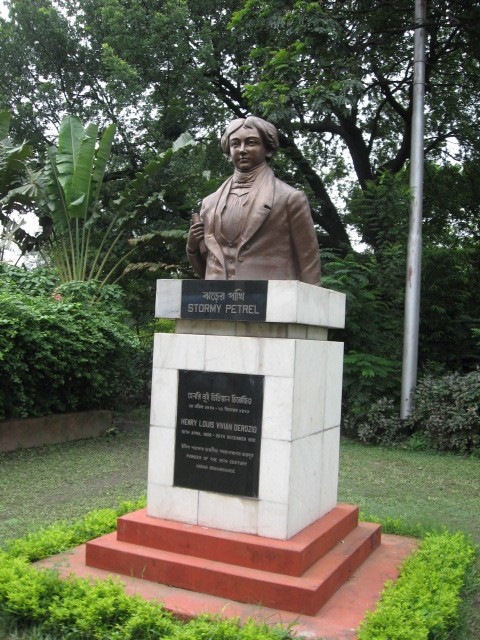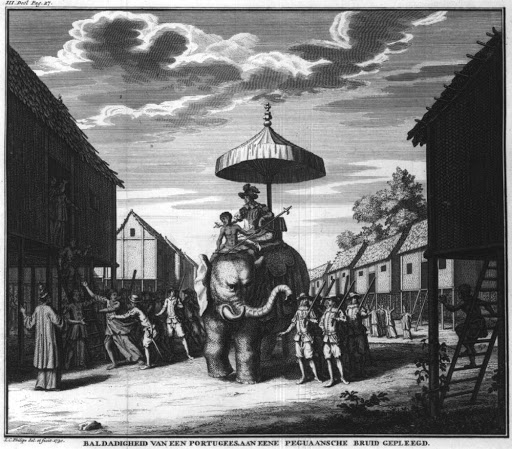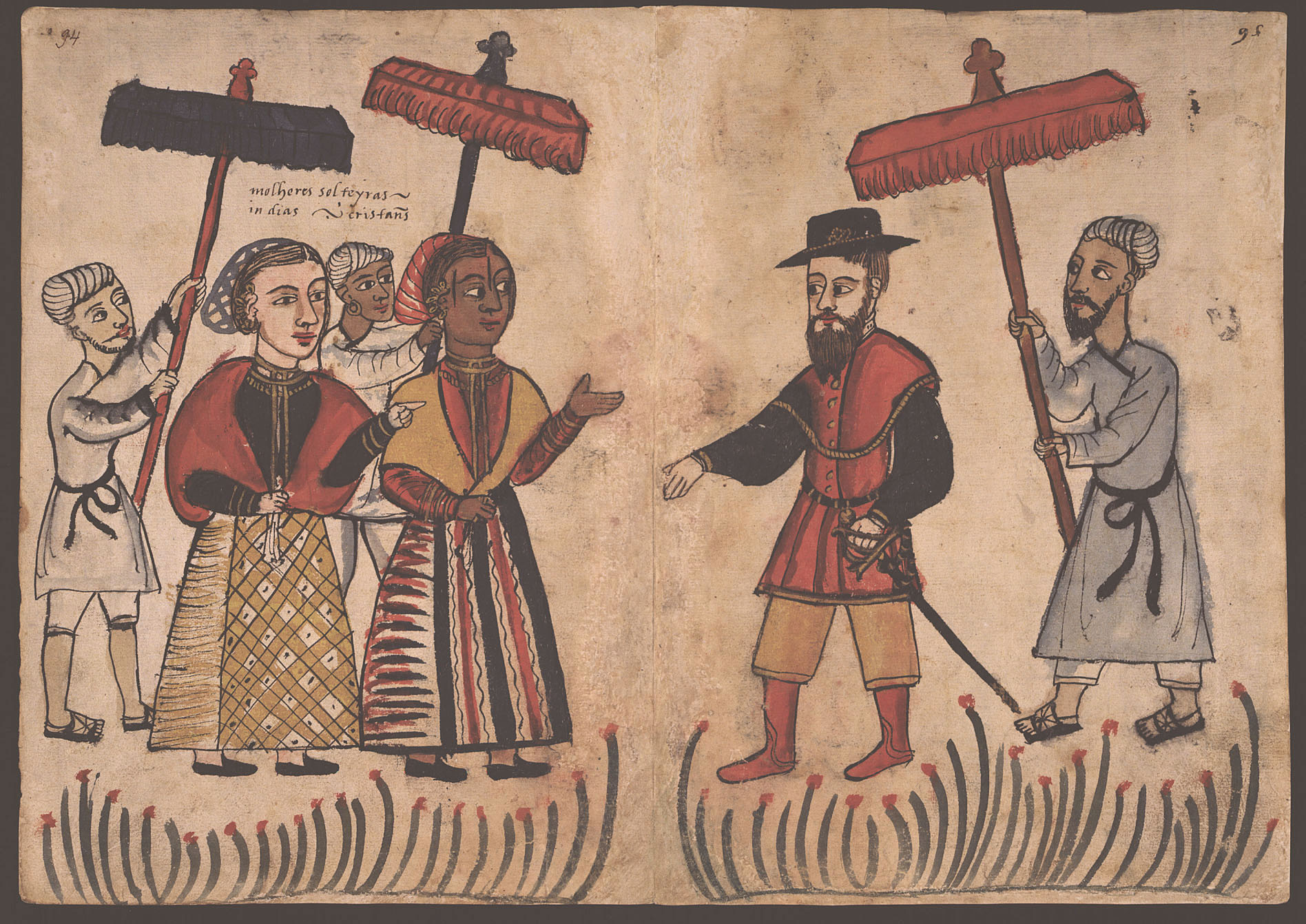|
Luso-Indian
Luso-Indians, or Portuguese-Indians, are people who have mixed Indian and Portuguese ancestry; the term also refers to people of Portuguese descent born or living or originating in former Portuguese Indian colonies, the most important of which were Goa and Damaon of the Konkan region, along the Western coast of the present-day Republic of India. Luso-Indians are one subgroup of Luso-Asians, which includes other Eurasian creole peoples. Their diaspora can be found around the world, particularly in the Anglosphere and the Lusosphere, including constiuents of the former Portuguese East Indies such as Macao. Pockets of Luso-Indians used to live in the parts of India now known as Anjediva, Velha Goa, Damaon, Dio district, St Mary's islands of Mangalore, Bombay (Mumbai), Korlai Fort ( Chaul), Vasai (Bassein), Silvassa, Cape Comorin & Fort Cochin. There are also a number of Koli Christians, Christian Brahmins, Christian Cxatrias & so on with Portuguese surnames but who d ... [...More Info...] [...Related Items...] OR: [Wikipedia] [Google] [Baidu] |
Luso-Asians
Luso-Asians (Portuguese: ''luso-asiáticos'') are Eurasian people whose ethnicity is partially or wholly Portuguese people, Portuguese and ancestrally are based in or hail primarily from Portugal, South Asia, Southeast Asia, and East Asia. They historically came under the cultural and multi-ethnic sway of the Portuguese Empire in Portuguese East Indies, the East and retain certain aspects of the Portuguese language, Roman Catholic faith, and Romanization (cultural), Latin cultural practices, including internal and external architecture, art, and cuisine that reflect this contact. The term ''Luso'' comes from the Roman Empire's province of Lusitania, which roughly corresponds to modern Portugal. Luso-Asian Art is also known as Indo-Portuguese Art (from India), Luso-Ceylonese Art (from Sri Lanka), Luso-Siamese Art (from Thailand), Luso-Malay (from Indonesia, Malaysia and Singapore), Sino-Portuguese Art (from China), or Nipo-Portuguese Art (from Japan). Examples of this art, especia ... [...More Info...] [...Related Items...] OR: [Wikipedia] [Google] [Baidu] |
Goan Catholics
Goan Catholics () are an Ethnoreligious group, ethno-religious community adhering to the Latin Church, Latin Rite of the Catholic Church from the Goa state, in the southern part of the Konkan region along the west coast of India. They are Konkani people and speak the Konkani language. Christianisation of Goa, Missionary activities followed soon after the Portuguese conquest of Goa. Pope Nicholas V had enacted the Papal bull of ''Romanus Pontifex'' in AD 1455, according to which the Padroado, patronage of the Christian faith in the East Indies, was granted to the Portuguese crown. Their culture is an amalgam of Konkani language, Konkani and Culture of Portugal, Portuguese cultures, with the latter having a more important role because Goa, Damaon & Diu had been ruled by Portugal from AD 1510–1961. The notion of Goa Special Status, Goan identity as a distinct culture among other Luso-Asians or Luso-Indian cultures was forged into India after the annexation of Goa and Damaon in 1 ... [...More Info...] [...Related Items...] OR: [Wikipedia] [Google] [Baidu] |
Bayingyi People
Bayingyi people () also known as Luso-Burmese, are a subgroup ethnicity of Luso-Asians, and are the descendants of Portuguese people, Portuguese mercenaries or adventurers who came to Myanmar (Burma) in the 16th and 17th centuries. They were recruited into the Royal Burmese armed forces, Royal Burmese Armed Forces' artillery and musketeers corps, and over centuries of continued settlement in the Mu River, Mu Valley, particularly the Sagaing Region of Myanmar, have been more or less Cultural assimilation, assimilated into the dominant ethnic group of the region, the Bamar people, Bamar, while keeping their sense of Portuguese identity and Catholic Church in Myanmar, Roman Catholic religion. Etymology The descendants of the Portuguese were once commonly known, because of their Caucasian race, Caucasian features, as “Bayingyi", but the everyday usage of the term, along with the Bayingyi's Europe, European appearance, has almost disappeared due to assimilation with the Bamar people ... [...More Info...] [...Related Items...] OR: [Wikipedia] [Google] [Baidu] |
Anglo-Indian People
Anglo-Indian people are a distinct minority community of mixed-race British and Indian ancestry. During the colonial period, their ancestry was defined as British paternal and Indian maternal heritage; post-independence, "Anglo-Indian" has also encompassed other European and Indian ancestries. Anglo-Indians' first language is usually English. Prior to 1911, various designations like "Eurasian" or "Indo-Briton" were used to describe this community. The All India Anglo-Indian Association, founded in 1926, has long represented the interests of this ethnic group; it holds that Anglo-Indians are unique in that they are Christians, speak English as their mother tongue, and have a historical link to both the British Isles and the Indian sub-continent. During the period of British rule in India, children born to unions between British fathers and Indian mothers from the 17th century onwards formed the basis of the Anglo-Indian community. This new ethnic group formed a small ye ... [...More Info...] [...Related Items...] OR: [Wikipedia] [Google] [Baidu] |
Indo-Portuguese Creoles
Indo-Portuguese creoles are the several Portuguese creoles spoken in the erstwhile Portuguese Indian settlements, Cochin Portuguese Creole, Fort Bassein, Goa and Damaon, Portuguese Ceylon etc; in present-day India and Sri Lanka. These creoles are now mostly extinct or endangered. They have substantial European Portuguese words in their grammars or lexicons: * Ceylon Portuguese creole ''(Sri Lanka)'' * Damaon and Dio Portuguese creole * Kristi language ( Chaul Portuguese creole) * Norteiro creole (Bassein) † * Bombay Portuguese creole † * Goa Portuguese creole † * Korlai Portuguese * Cochin Portuguese creole † * Cannanore Portuguese creole * Bengali Portuguese creole † The expression Indo-Portuguese may refer not only to the creoles but also to the creole people groups of Luso-Indians and Portuguese Burghers, who spoke them on the Indian subcontinent The Indian subcontinent is a physiographic region of Asia below the Himalayas which projects into th ... [...More Info...] [...Related Items...] OR: [Wikipedia] [Google] [Baidu] |
Korlai Indo-Portuguese
Korlai Portuguese is an Indo-Portuguese creole based on the Portuguese language, spoken by approximately 1,000 inhabitants of the Korlai village at the Korlai fort, a former possession of the Portuguese in Goa and Bombay. Their speech is referred to as Korlai creole, Korlai Portuguese, Kristi or ''Nɔw-ling'' by the speakers themselves, which translates to "our language" in the creole. The speakers are a part of a very close-knit community, and refer to themselves as the ''Kristi'' community bound by their affiliation to the Christian denomination, of Roman Catholicism in India. Korlai is situated in the Raigad district ( Colaba district) of the Konkan division named after the Colaba fort, 150 kilometers south of Mumbai (Bombay), in Maharashtra, India. The speakers are of a homogenous Roman Catholic pocket in an area otherwise dominated by Konkani Muslim and Hindu Marathi-Konkani speaking inhabitants. Development of Korlai Creole Portuguese The development of the lang ... [...More Info...] [...Related Items...] OR: [Wikipedia] [Google] [Baidu] |
Mangalorean Catholics
Mangalorean Catholics () are an ethno-religious community of Latin Church in India, Latin Christians from the Roman Catholic Diocese of Mangalore, Diocese of Mangalore and the erstwhile South Canara area; by the southern coast of present-day Karnataka, India. Contemporary Mangalorean Catholics descend mainly from the New Christians of Portuguese Goa, who migrated to the Keladi Kingdom 1560-1763, throughout the courses of the Goan Inquisition, the Portuguese–Adil Shahi Wars & the Mahratta Invasion of Goa and Bombay, Mahratta Invasions of Goa and Bombay. They learned Tulu language, Tulu and Kanarese whilst in Canara, but retained the Konkani language and preserved much of their Konkani people, Konkani way of life, which had undergone Christianisation in Goa. The "Canara Christians" faced a Captivity of Mangalorean Catholics at Seringapatam, 15-year-long captivity at Seringapatam, imposed by Tippu Sultan. Following Tippu's defeat and death at the Siege of Seringapatam (1799) by th ... [...More Info...] [...Related Items...] OR: [Wikipedia] [Google] [Baidu] |
Portuguese Burghers
The Portuguese Burghers are an ethnic group in Sri Lanka, of mixed Portuguese and Sri Lankan descent. They are largely Catholic and some still speak the Sri Lanka Indo-Portuguese language, a creole based on Portuguese mixed with Sinhalese. In modern times, English has become the common language while Sinhalese is taught in school as a second language. Portuguese Burghers sometimes mixed with but are to be distinguished from other Burgher people, such as Dutch Burghers. Origins The Portuguese Burghers are largely descendants of the Sri Lanka Mestiços, the people of mixed Portuguese and Sri Lankan descent (commonly of a Portuguese father and a Sri Lankan mother) who appeared in the 16th century, after the Portuguese explorers found the sea route to the Indian Ocean. When the Dutch took over coastal Sri Lanka (formerly Ceylon), the descendants of the Portuguese took refuge in the central hills of Kandyan Kingdom under Sinhalese rule. In time, the Dutch and Portuguese desce ... [...More Info...] [...Related Items...] OR: [Wikipedia] [Google] [Baidu] |
Gujarat
Gujarat () is a States of India, state along the Western India, western coast of India. Its coastline of about is the longest in the country, most of which lies on the Kathiawar peninsula. Gujarat is the List of states and union territories of India by area, fifth-largest Indian state by area, covering some ; and the List of states and union territories of India by population, ninth-most populous state, with a population of 60.4 million in 2011. It is bordered by Rajasthan to the northeast, Dadra and Nagar Haveli and Daman and Diu to the south, Maharashtra to the southeast, Madhya Pradesh to the east, and the Arabian Sea and the Pakistani province of Sindh to the west. Gujarat's capital city is Gandhinagar, while its largest city is Ahmedabad. The Gujarati people, Gujaratis are indigenous to the state and their language, Gujarati language, Gujarati, is the state's official language. The state List of Indus Valley civilisation sites#List of Indus Valley sites discovered, ... [...More Info...] [...Related Items...] OR: [Wikipedia] [Google] [Baidu] |
Henry Louis Vivian Derozio
Henry Louis Vivian Derozio (18 April 1809 – 26 December 1831) was an Indian poet and assistant headmaster of Hindu College, Kolkata. He was a radical thinker of his time and one of the first Indian educators to disseminate Western learning and science among the young men of Bengal. Long after his early death, his legacy lived on among his former students, who came to be known as Young Bengals and many of whom became prominent in social reform, law, and journalism. Biography Early life Henry Louis Vivian Derozio was born on 18 April 1809 at Entally-Padmapukur in Kolkata. His parents were Francis Derozio, a Christian Luso-Indian, Indo-Portuguese office worker, and Sophia Johnson Derozio, an Anglo-Indian woman. His original family name was "do Rozário". Derozio attended David Drummond Dharmatala Academy school from age 6 to 14. He later praised his early schooling for its liberal approach to education, particularly its unusual choice to teach Indian, Eurasian and European chil ... [...More Info...] [...Related Items...] OR: [Wikipedia] [Google] [Baidu] |
Telugu Language
Telugu (; , ) is a Dravidian languages, Dravidian language native to the Indian states of Andhra Pradesh and Telangana, where it is also the official language. Spoken by about 96 million people (2022), Telugu is the most widely spoken member of the Dravidian language family, and one of the twenty-two Languages with legal status in India, scheduled languages of the Republic of India. It is one of the few languages that has primary official status in more than one States and union territories of India, Indian state, alongside Hindi and Bengali language, Bengali. Telugu is one of the languages designated as a Classical Languages of India, classical language by the Government of India. It is the 14th most spoken native language in the world.Statistics in Modern Standard Telugu is based on the dialect of erstwhile Krishna, Guntur, East Godavari and ... [...More Info...] [...Related Items...] OR: [Wikipedia] [Google] [Baidu] |
Hinduism
Hinduism () is an Hypernymy and hyponymy, umbrella term for a range of Indian religions, Indian List of religions and spiritual traditions#Indian religions, religious and spiritual traditions (Sampradaya, ''sampradaya''s) that are unified by adherence to the concept of ''dharma'', a Ṛta, cosmic order maintained by its followers through rituals and righteous living, as expounded in the Vedas. The word ''Hindu'' is an exonym, and while Hinduism has been called the oldest religion in the world, it has also been described by the modern term ''Sanātana Dharma'' () emphasizing its eternal nature. ''Vaidika Dharma'' () and ''Arya dharma'' are historical endonyms for Hinduism. Hinduism entails diverse systems of thought, marked by a range of shared Glossary of Hinduism terms, concepts that discuss God in Hinduism, theology, Hindu mythology, mythology, among other topics in Hindu texts, textual sources. Hindu texts have been classified into Śruti () and Smṛti (). The major Hin ... [...More Info...] [...Related Items...] OR: [Wikipedia] [Google] [Baidu] |






